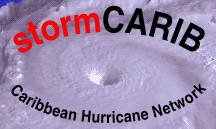
 |
A Practical Guideto hurricane tracking and plotting |
|
|
Welcome to the practical guide to hurricane plotting and tracking, filled with tid-bits and other miscellaneous information. Here you may find the answer to a lot of your trivial (but oh so frustrating when you can't find the answer) questions. Somewhere else on our website we have information available on the current situation in the Caribbean. Our special local hurricane correspondents report from the Caribbean Islands about the situation with regards to threatening tropical systems. Reliable reports from the people who are in the middle of it all! For the latest advisories and satellite images see our Quick Hurricane Web Resource Locator, which will help you find the least overloaded web-server. Comments can be addressed to Gert van Dijken, site maintainer.
- - - Do you live in the Caribbean? - - - |
|
Brought to you by GoBeach Vacations (gobeach.com) |
A practical guide to hurricane tracking and plotting
Tracking and plotting the coordinates of the current position and its forecast of hurricanes is fun (as long as the eye stays away...)! But sometimes confusing! Those advisories from the National Hurricane Center use all those different units; knots, kilometers, miles, nautical miles, etc. Not sure about how many nautical miles are in a kilometer? Or how knots relate to miles per hour? And how can I calculate without too much work how far a storm is located from the Caribbean Islands. When are they going to use your name for a Hurricane? Who came up with the titles of the National Hurricane Advisories; WTNT32.KNHC, MIASPFAT3, what do they mean? And then you've been looking at the strike probabilities of the storm, but the advisories are using those strange abbreviations, which island is TDPR or what's the code for St.Martin? More questions. When is a tropical system a tropical storm and when becomes it a Category 3 hurricane? Will my mobile home survive this storm? These facts are so trivial, but sometimes so hard to find. Very annoying when you are tracking and plotting Hurricane Edouard, Fran, Hortense or whoever. This page should give you the answers to these questions, and more... Also, don't miss the feature about the Hurricane Hunters. These brave guys fly right into the eye of a hurricane to get the valuable data for hurricane forecasting! It is written by Martha Watkins Gilkes, and was published in the LIAT Islander Inflight Magazine. |
Wondering when they are going to use your name for a tropical system? If they haven't used it in the last 6 years, the chance is pretty small that they ever will. This because hurricane names are recycled every 6 years. So the list of names for 1996 will be used again in 2002. However, often the names of some famous hurricanes have been dropped and replaced with something else. E.g. Luis has been replaced by Lorenzo and Andrew by Alex. It's likely that 1998 storms Georges and Mitch will become 'classics' as well. The names for the Atlantic are:
2001 2002 2003 2004 2005 2006
1. Allison Arthur Ana Alex Arlene Alberto
2. Barry Bertha Bill Bonnie Bret Beryl
3. Chantal Cristobal Claudette Charley Cindy Chris
4. Dean Dolly Danny Danielle Dennis Debby
5. Erin Edouard Erika Earl Emily Ernesto
6. Felix Fay Fabian Frances Franklin Florence
7. Gabrielle Gustav Grace Gaston Gert Gordon
8. Humberto Hanna Henri Hermine Harvey Helene
9. Iris Isidore Isabel Ivan Irene Isaac
10. Jerry Josephine Juan Jeanne Jose Joyce
11. Karen Kyle Kate Karl Katrina Kirk
12. Lorenzo Lili Larry Lisa Lee Leslie
13. Michelle Marco Mindy Matthew Maria Michael
14. Noel Nana Nicholas Nicole Nate Nadine
15. Olga Omar Odette Otto Ophelia Oscar
16. Pablo Paloma Peter Paula Philippe Patty
17. Rebekah Rene Rose Richard Rita Rafael
18. Sebastien Sally Sam Shary Stan Sandy
19. Tanya Teddy Teresa Tomas Tammy Tony
20. Van Vicky Victor Virginie Vince Valerie
21. Wendy Wilfred Wanda Walter Wilma William
When all names are exhausted we will go over to the Greek alphabeth, like Alpha, Beta, Gamma, etc. However, in 2021 the World Meteoroligical Organization decided to use a supplemental list of names. Apparently the Greek letters were confusing to use, and you cannot really retire a Greek letter. Names on the list are: Adria, Braylen, Caridad, Deshawn, Emery, Foster, Gemma, Heath, Isla, Jacobus, Kenzie, Lucio, Makayla, Nolan, Orlanda, Pax, Ronin, Sophie, Tayshaun, Viviana, Will.
There is a storm brewing out there in the Atlantic, and you are wondering "How close is it?". Now you can accurately calculate the distance between the eye of the hurricane and your island. Just select your island and hurricane specifics like, the latitude and longitude coordinates of the storm and click on 'Show me how close...'. If your island is not listed you can enter your own coordinates.
In addition, you can enter the forward speed at which the hurricane is moving to calculate the time before the eye makes landfall at your location. If you know how far tropical storm winds extend from the center of the storm you can enter those as well to calculate how much preparation time you have left before winds will be blowing at tropical storm force. Caution: the numbers you get will only be true if the hurricane will travel in a straight line to your island at a constant speed and when you assume that the wind field doesn't change, in other words doesn't strengthen or weaken, over that time [this is normally not the case!!!].
Another tool available on this website calculates the closest point of approach of the eye of the storm to where you live from the 5-day forecast issued by the National Hurricane Center.